National Maritime Museum websites use cookies to improve your website experience and also for statistical purposes. Unless you modify your browser settings, using any of the NMM websites will result in the storage of cookies on your device. You can limit or block cookie files by modifying your Internet browser settings.

Narodowe Muzeum Morskie w Gdańsku
- Virtual Open-Air Museum of Wrecks
Current language
- Opening hours
- Ticket prices
- Current exhibitions
- Terms and conditions of visiting
- Vision and Mission
- Departments
- History of the Museum
- Wrecks researched by NMM
- Contact intormation
- 2 Ships – Common Sea
- EU Projects
- Crane Project
- CKWS Project
- OKM Project
- EEA/Norway Grants
- MKDNiS Projects
- The Granaries
- Maritime Culture Centre
COVID-19 Information
Restrictions and limitations inside the branches of the National Maritime Museum in Gdańsk - read
- I am sailing "Opty". Treasures...
Ten wpis jest archiwalny.
I am sailing "Opty". Treasures from the Voyage Around the Globe
11.07.2019 |
Send a message |
Message to Webmaster

In 2019, we have been celebrating the 50th anniversary of the end of voyage by Leonid Teliga on board of "Opty". "I am sailing "Opty" Exhibition. Treasures from the voyage around the globe in the Vistula Museum in Tczew present the history of great adventure, legendary sailor and yacht – the symbol. Sails, sea anchor, boatswain's chair, foghorn, speaking tube, log book, personal belongings of Leonid Teliga, letters for the captain – these are some of numerous exhibits presented in the branch of the National Maritime Museum, in Tczew. So far only some of the exhibits were presented to the public. Today, they remind us of the history from more than half a century ago, presenting the atmosphere of the first Polish single-handed voyage around the globe. The renovated yacht, "Opty" is presented in the neighbouring Shipwreck Conservation Centre. - The exhibition, "I am sailing Opty" is a tribute to Leonid Teliga and remembrance of a very important anniversary in the Polish sailing history – says the exhibition curator, Radosław Paternoga – the National Maritime Museum in Gdańsk has a large legacy of the captain in the form of valuable exhibits, related to the legendary voyage as well as the historic yacht. While preparing the exhibition we knew it would be based on our collection. This time, we have included neither any multimedia, theatrical scenography nor computer animation. In this exhibition, space and light were also significant. We wanted to give our guests sufficient space so that they could feel like sailing on board of Opty together with Leonid Teliga – Radosław Paternoga says.
Soldier, Sailor and Journalist Leonid Teliga was born on 28 May 1917 in Vyazma, in Russia. He spent his childhood and youth in Grodzisk Mazowiecki. In 1938, after graduating the Infantry Cadet School, he was allotted as a Second Lieutenant to the 44th Rifle Regiment in Rowne. During the defensive war of 1939, he fought near Tomaszów Mazowiecki, where he was wounded. He went with his regiment to Volhynia, where he fell into the Soviet captivity. Later, he became a fisherman and worked on fishing cutters on the Don River as well as the Sea of Azov and the Black Sea. In 1942, he joined the Polish Army formed by gen. Władysław Anders, and went to Great Britain. After the training in Canada, as air gunner, he fought in No. 300 Polish Bomber Squadron "Land of Mazovia". In 1947, he returned to Poland. He was employed at the Press Department of the Ministry of Foreign Affairs and later worked at the editorial office of "Sztandar Młodych". During holidays, he worked as a fisherman in the Fishery and Fishing Service Company "Arka" in Gdynia. In 1957, he went to Korea to work at the UN Arbitration Commission. At the same time, he was involved in writing short stories and translating. He was also a regular correspondent of the Polish Press Agency in Rome. In 1963, he returned to the African fishing grounds and a year later he began working for the International Commission for Supervision and Control in Laos. Passion for Sailing Leonid Teliga was developing his passion for sailing already as a young boy, living in Grodzisk Mazowiecki. His interests solidified during his military service; he obtained the coxswain license during the sailing course in Jastarnia. The first, timid plan for the voyage around the globe appeared after the war; Teliga was dreaming about returning from Great Britain to Poland around the globe. Unfortunately, at that time his project could not have been conducted. When he returned to Poland, he began teaching young sailors at courses organized by the Maritime League, mainly on the Vistula River and in Giżycko. In 1956, after years of restrictions imposed by the government, he could finally sail for the first time in the Baltic Sea. On another voyage, he went as a journalist on board of „Dar Pomorza”. Yet, all the time he was thinking about the solitary voyage around the globe. It had never been done before by a Pole. Planning the voyage, he never considered renting the yacht from his Marine Yacht Club "Gryf". He chose a solution, for those times, nearly impossible to reach – the construction of his own yacht. He was already saving money for that purpose. He chose "Tuńczyk" type construction and commissioned a young boat builder from Gdynia – Maciej Dowhyluk, to build the yacht. The construction was in progress between 1965 and 1966, and the yacht was named "Opty" – from the word "optimist". Voyage Timetable
- 25.01.1967 – beginning of voyage in Casablanca
- 12.02.1967 – arrival at the Canary Islands
- 16.04.1967 – arrival at Barbados
- 1.07.1967 – passage through the Panama Canal
- 20.09.1967 – arrival at Galapagos Islands
- 26.11.1967 – arrival at the Marquesas Islands
- 31.12.1967 – arrival at Tahiti
- 2.06.1968 – arrival at Fiji
- 9.01.1969 – arrival at Dakar
- 5.04.1969 – closure of circumearth loop
- 16.04.1969 – arrival at Las Palmas
- 30.04.1969 – end of voyage in Casablanca
Success, Fame, Remembrance Leonid Teliga became the first Polish sailor who single-handedly circumnavigated the globe. During the voyage, he faced not only the nature of the seas but also serious illness. His achievement won significant acclaim, and the success of voyage and Teliga himself was proven by meetings with thousands of people as well as numerous awards and distinctions granted to the sailor. Unfortunately, despite the operation performed after his return, Leonid Teliga died on 21 May 1970 in Warsaw, remaining an example to follow for many generations of sailors. His achievement became inspiration for his followers. To commemorate Leonid Teliga, the Marine Boatyard in Szczecin was named after him. He is also the patron of numerous scout troops, marine teams and schools. The editorial office of "Żagle" monthly magazine grants annual Leonid Teliga awards for the marine-related publication, sailing achievement and promotion of sailing in Poland. The monuments of famous sailor can be found in Gdynia and Grodzisk Mazowiecki. Read also: OPTY – yacht which sailed around the world
Current exhibition "I am sailing "Opty". Treasures from the Voyage Around the Globe" 5.07.2019 - 14.06.2020 Vistula River Museum in Tczew

- Granaries on Ołowianka Island
- „Dar Pomorza”
- Fisheries Museum
- Vistula Lagoon Museum
- Vistula River Museum
- Shipwreck Conservation Centre

- Opus opificem probat

Copyright © 2024 National Maritime Museum in Gdańsk . All rights reserved
Project & development AM Creative

- Pages containing bot parameter
- Articles with dead external links from September 2014
- Articles incorporating text from Wikipedia
- 1917 births
- 1970 deaths
- Single-handed circumnavigating sailors
- Polish military personnel of World War II
Leonid Teliga
- View history
Leonid Teliga (28 May 1917 – 21 May 1970) was a Polish sailor, writer, journalist, translator and the first Pole to single-handedly circumnavigate the globe on his yawl Opty .
- 1.2 During and after World War II
- 1.3 Circumnavigation of the Earth
- 2 References
- 3 Bibliography
- 4 External links
Although he was born in Russia, his parents decided to settle back in Poland after it regained independence. He was raised in Grodzisk Mazowiecki . After failing to get into medical studies, he decided to attend military academy. In 1937, he finished a yachting course in Jastarnia .
During and after World War II [ ]
During the September Campaign Teliga fought in 44th Infantry Regiment, and was wounded at Tomaszów Mazowiecki . In 1940, he arrived in Azov, where he took a skipper course and became a fisherman. Eventually, he took part in the evacuation of harbours on Crimea. In 1942, he joined the newly-formed Anders Army , established in the Soviet Union and made up mainly of Polish POWs , with which he got through to Great Britain. After taking a navigation course in Canada, he fought as a gunner in the No. 300 Squadron , a unit of the Polish Air Forces in Great Britain .
Teliga returned to Poland in 1947. He used every occasion to return to the sea, sometimes as a skipper or sailing instructor, later as a journalist. In the 50s and 60s, he published several short stories collections and novels based on his various voyages. In 1957, Teliga went to North Korea to participate in the works of UN Armistice Commission.
Circumnavigation of the Earth [ ]

Sailing yacht Opty - boat of Leonid Teliga, the first Pole who single-handedly circumnavigated the globe. Presently on exhibition in Shipwreck Conservation Centre in Tczew
The yacht Opty was designed by engineer Leon Tumiłowicz, based on his earlier construction, the Tuńczyk class, but modified so that it would better fit the task of long, solitary cruise. Tuńczyk 's predecessor, the Konik Morski type, was actually the first Polish seagoing construction, designed back in 1936. The construction of Opty began in January 1966, and finished in October. Although he received some support from Polish Yachting Association and other sources, Teliga funded the construction mostly on his own. Even though masts and booms were wooden, the yacht was fairly well equipped, as it had a pneumatic raft, a plastic boat for easier communication with the coast, and a wide set of sails for every kind of wind.
After having Opty transported to Casablanca, Teliga began his journey on 25 January 1967, heading west. During the course of the cruise, he visited Canary Islands, Lesser Antilles, Panama Canal, Galápagos Islands, Marquesas Islands, Tahiti, Bora Bora , Fiji and Dakar. In Panama Canal, he experienced an unexpected delay as it took eleven days to persuade the Canal's administration to let him pass. Most likely that was the reason for him to skip Australia and do the final section of the circumnavigation without any landings, as after failing to get Australian visa he expected similar obstructions there. [1]
During his journey, Teliga became fairly well known, and acquired honorary membership of several yacht clubs. He experienced a hospitable welcome in nearly every port, and, incidentally, met compatriots in most of them.
By cruising non-stop from Fiji to Dakar for 165 days, he beat the world record previously held by Bernard Gilboy , who sailed single-handedly for 163 days in an attempt to cross the Pacific Ocean. However, when Teliga landed in Dakar on 9 January 1969, Robin Knox-Johnston has already been at sea for 210 days.
On 5 April 1969, he crossed his course from 1967, finishing the circumnavigation. It took him "2 years, 13 days, 21 hours and 15 minutes" [2]
Due to rapidly developing cancer, Teliga was forced to stop in Casablanca. He was transported back to Poland by plane. Despite having an operation, he died in May 1970.
References [ ]
- ↑ Teliga, Leonid (1973). Samotny rejs "Opty" . Wydawnictwo Morskie. pp. 302–304.
- ↑ Teliga, Leonid (1973). Samotny rejs "Opty" . Wydawnictwo Morskie. pp. 411.
Bibliography [ ]
- Leonid Teliga - Polish Sailing Encyclopedia [ dead link ] (pl.)
External links [ ]
- Information on the yacht Opty - Polish Sailing Encyclopedia (pl.) [ dead link ]
For full functionality of this site it is necessary to enable JavaScript. Here are the instructions how to enable JavaScript in your web browser .
- Log in / Register
Your download will start shortly, please do not navigate away from this page until the download prompt has appeared. Doing so may cause your download to be interrupted.
shipstamps.co.uk

- Board index Ship Stamps Ship Stamps Collection
Post by aukepalmhof » Wed Jan 06, 2010 8:20 pm
Re: OPTY yacht
Post by Arturo » Fri Jan 30, 2015 9:14 pm
Return to “Ship Stamps Collection”
- ↳ New Members
- ↳ General Discussion
- Ship Stamps
- ↳ Ship Stamps Collection
- ↳ Shipping Lines and Shipbuilders
- ↳ Post your stamps here
- ↳ Unidentified ships on stamps
- ↳ For Sale / Wanted
- ↳ Links, affiliates and special offers
Category: Regina (ship, 1989)
Media in category " regina (ship, 1989)".
This category contains only the following file.

- Ships built in 1989
- Sailing yachts by name
- Sailing yachts of Estonia
- Ships built in Poland
- Ships of Estonia by name
- Ships named Regina
- Ships registered in Roomassaare
- Ships by name (flat list)
Navigation menu


Vessel stats
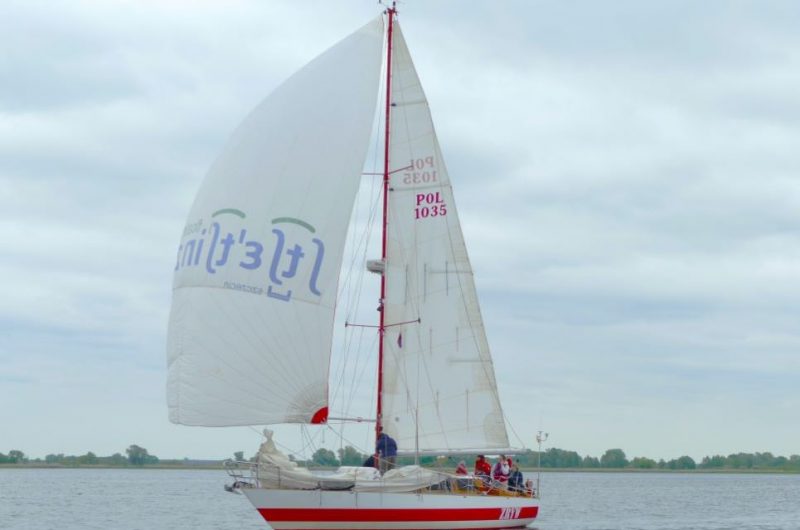
Specification
- Nationality: Poland
- Year built: 1978
- Home port: Szczecin
- Rig: Bm Sloop
- Height: 15.75 m
- Length of hull: 10.57 m
- Entered by: City of Szczecin
- Number of trainees: 6
- Number of permanent crew: 2
Tall ship races and regattas
- Future events: The Tall Ships Races 2024
- Past events: The Tall Ships Races 2022 , The Tall Ships Races 2017
S/y Zryw was built in 1978 in the Maritime Yacht Shipyard of Leonid Teliga. She is used as a sail training vessel for adolescents and to help them pass the Polish Certificate of Competency. These young sailors gather experience from voyages in the Baltic Sea.
Within the last 2 years, Zryw sailed twice around the Baltic and once to the northern edge of the Gulf of Bothnia. Then the crew passed the Arctic Circle. Both voyages were rewarded with the local Sailing-tourists Award of the year. Zryw still looks as new, thanks to a hard working and caring crew who have built a strong bond with the yacht.
Oman Bursary Scheme 2024 Opens for Applications
A final parade and prizes in cadiz, the final celebrations begin in cadiz.
- You are here
- Everything Explained.Today
- A-Z Contents
- Leonid Teliga
Leonid Teliga Explained
Leonid Teliga (28 May 1917 - 21 May 1970) was a Polish sailor, writer, journalist, translator, and the first Pole to single-handedly circumnavigate the globe on his yawl Opty .
Although he was born in Russia, his parents decided to settle back in Poland after it regained independence. He was raised in Grodzisk Mazowiecki . After failing to get into medical studies, he decided to attend military academy. In 1937 he finished a yachting course in Jastarnia .
During and after World War II
During the September Campaign Teliga fought in 44th Infantry Regiment, and was wounded at Tomaszów Mazowiecki . In 1940 he arrived in Azov , where he took a skipper course and became a fisherman. Eventually he took part in the evacuation of harbours on Crimea . In 1942 he joined the newly-formed Anders Army , established in the Soviet Union and made up mainly of Polish POW s, with which he got through to Great Britain. After taking a navigation course in Canada, he fought as a gunner in the No. 300 Squadron , a unit of the Polish Air Forces in Great Britain .
Teliga returned to Poland in 1947. He used every occasion to return to the sea, sometimes as a skipper or sailing instructor, later as a journalist. In the 1950s and 1960s he published several short story collections and novels based on his various voyages. In 1957 Teliga went to North Korea to participate in the works of UN Armistice Commission.
Circumnavigation of the Earth
The yacht Opty was designed by engineer Leon Tumiłowicz, based on his earlier construction, the Tuńczyk class, but modified so that it would better fit the task of long, solitary cruise. Tuńczyk 's predecessor, the Konik Morski type, was the first Polish seagoing construction, designed in 1936. The construction of Opty began in January 1966 and finished in October. Although he received some support from Polish Yachting Association and other sources, Teliga funded the construction mostly on his own. Even though its masts and booms were wooden, the yacht was fairly well equipped, as it had a pneumatic raft, a plastic boat for easier communication with the coast, and a wide set of sails for every kind of wind.
After having Opty transported to Casablanca, Teliga began his journey on 25 January 1967, heading west. During the course of the cruise he visited Canary Islands , Lesser Antilles , Panama Canal , Galápagos Islands , Marquesas Islands , Tahiti , Bora Bora , Fiji , and Dakar . In Panama Canal he experienced an unexpected delay, as it took eleven days to persuade the Canal's administration to let him pass. Most likely this was the reason for him to skip Australia and do the final section of the circumnavigation without any landings, as after failing to get Australian visa he expected similar obstructions there. [1]
During his journey, Teliga became fairly well known, and acquired honorary membership of several yacht clubs. He experienced a hospitable welcome in nearly every port, and, incidentally, met compatriots in most of them.
Cruising non-stop from Fiji to Dakar for 165 days, he beat the world record previously held by Bernard Gilboy, who sailed single-handedly for 163 days in an attempt to cross the Pacific Ocean. However, when Teliga landed in Dakar on 9 January 1969, Robin Knox-Johnston has already been at sea for 210 days.
On 5 April 1969 he crossed his course from 1967, finishing the circumnavigation. It took him "2 years, 13 days, 21 hours and 15 minutes" [2]
Due to rapidly developing cancer, Teliga was forced to stop in Casablanca. He was transported back to Poland by plane. Despite having an operation, he died in May 1970.
Bibliography
- Leonid Teliga - Polish Sailing Encyclopedia (pl.)
External links
- Information on the yacht Opty - Polish Sailing Encyclopedia (pl.)
Notes and References
- Book: Teliga, Leonid . Samotny rejs "Opty" . 1973 . Wydawnictwo Morskie . 302–304.
- Book: Teliga, Leonid . Samotny rejs "Opty" . 1973 . Wydawnictwo Morskie . 411.
This article is licensed under the GNU Free Documentation License . It uses material from the Wikipedia article " Leonid Teliga ".
Except where otherwise indicated, Everything.Explained.Today is © Copyright 2009-2024, A B Cryer, All Rights Reserved. Cookie policy .
- Bahasa Indonesia
- Slovenščina
- Science & Tech
- Russian Kitchen
How the assassination of Stalin’s friend triggered the ‘Great Terror’ in the USSR
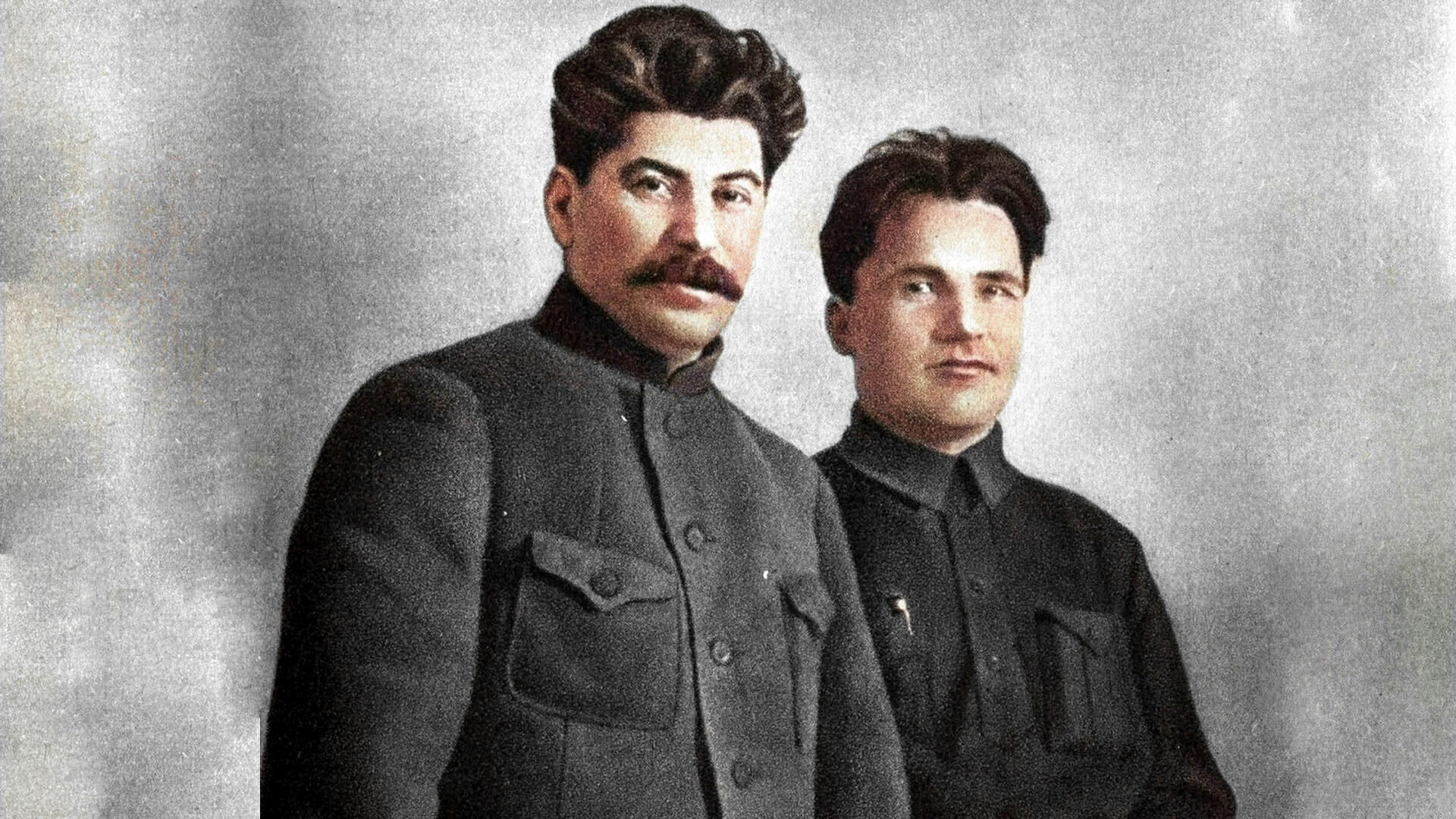
Joseph Stalin and Sergei Kirov.
On December 1, 1934, a murder took place in Leningrad (now St. Petersburg) that shocked the entire Soviet Union. Sergei Kirov, first secretary of the Leningrad Regional Party Committee and City Party Committee (de facto chief of the city), a close ally and friend of Stalin, was shot dead.
The crime was one of the main triggers for the start of the massive wave of political repression in the USSR, infamously known as the ‘Great Terror’. It still remains a mystery, however, whether the assassination was motivated by personal revenge on the part of a desperate loner or whether it was plotted in the country’s highest echelons of power.
High-profile crime
Thirty-year-old Leonid Nikolayev was waiting for Kirov at half past four in the afternoon outside his private office in the Smolny Institute, the building in which the city administration was housed. He killed the official with a single shot to the back of the head and then tried to shoot himself, but was prevented from doing so by witnesses to the crime who got to him in time.
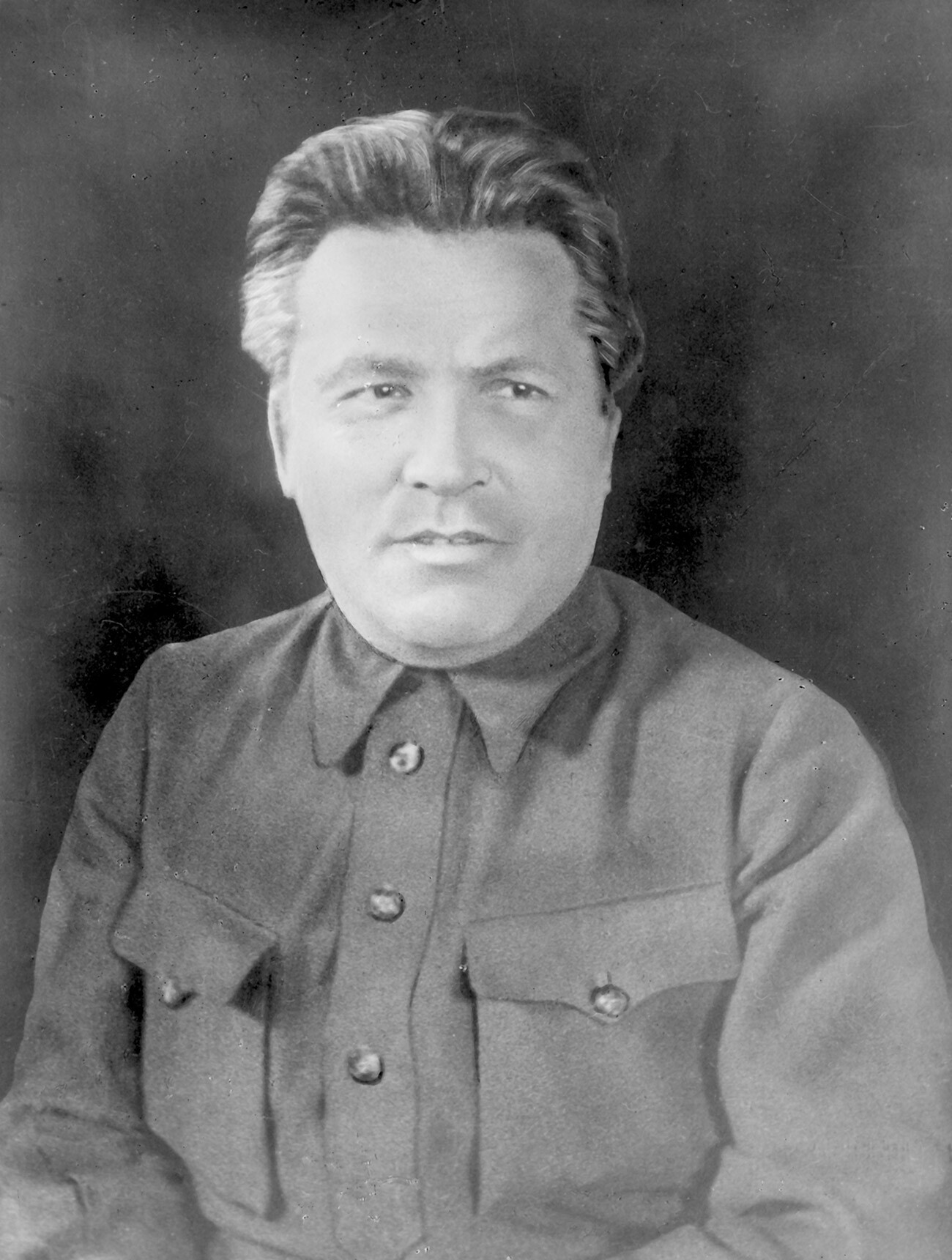
Sergei Kirov.
It turned out that the murderer was a member of the Bolshevik Party who had once worked for the authorities himself, but had been dismissed because of his propensity for constant arguments. Having failed to find a job, Nikolayev spent a long time filing complaints and petitions to his superiors (including Kirov), but all in vain.
Apart from resentment, another motive for the crime could have been jealousy. The investigation established that Nikolayev suspected his wife, Milda Draule, who also worked at the Smolny Institute, of having an affair with Kirov.
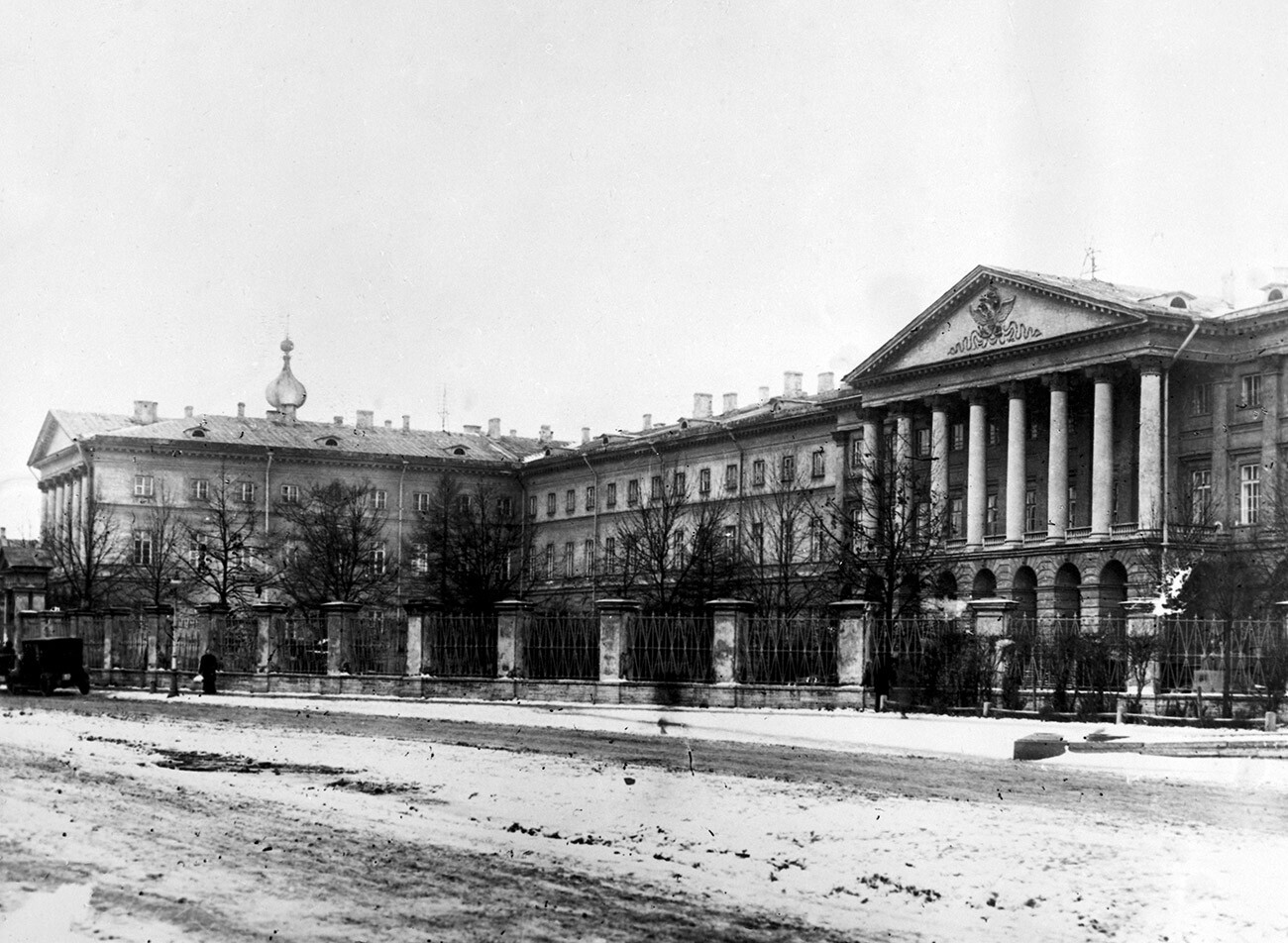
The Smolny Institute.
Previously, on October 15, the first secretary’s guards had detained Nikolayev with a revolver outside Kirov’s house, but, after checking his firearm certificate and party membership card, let him go. The same card helped the murderer get into the Regional Party Committee building unchallenged on the fateful day on December 1.
Personal record
As early as the morning of December 2, a train carrying members of the Soviet government arrived in Leningrad from Moscow. “You didn’t keep him safe!” Joseph Stalin declared irritatedly to the delegation meeting him on the platform. At that time, he was secretary of the VKP(b) [All-Union Communist Party (Bolsheviks)] Central Committee, but had already essentially concentrated all the power in the country in his own hands.
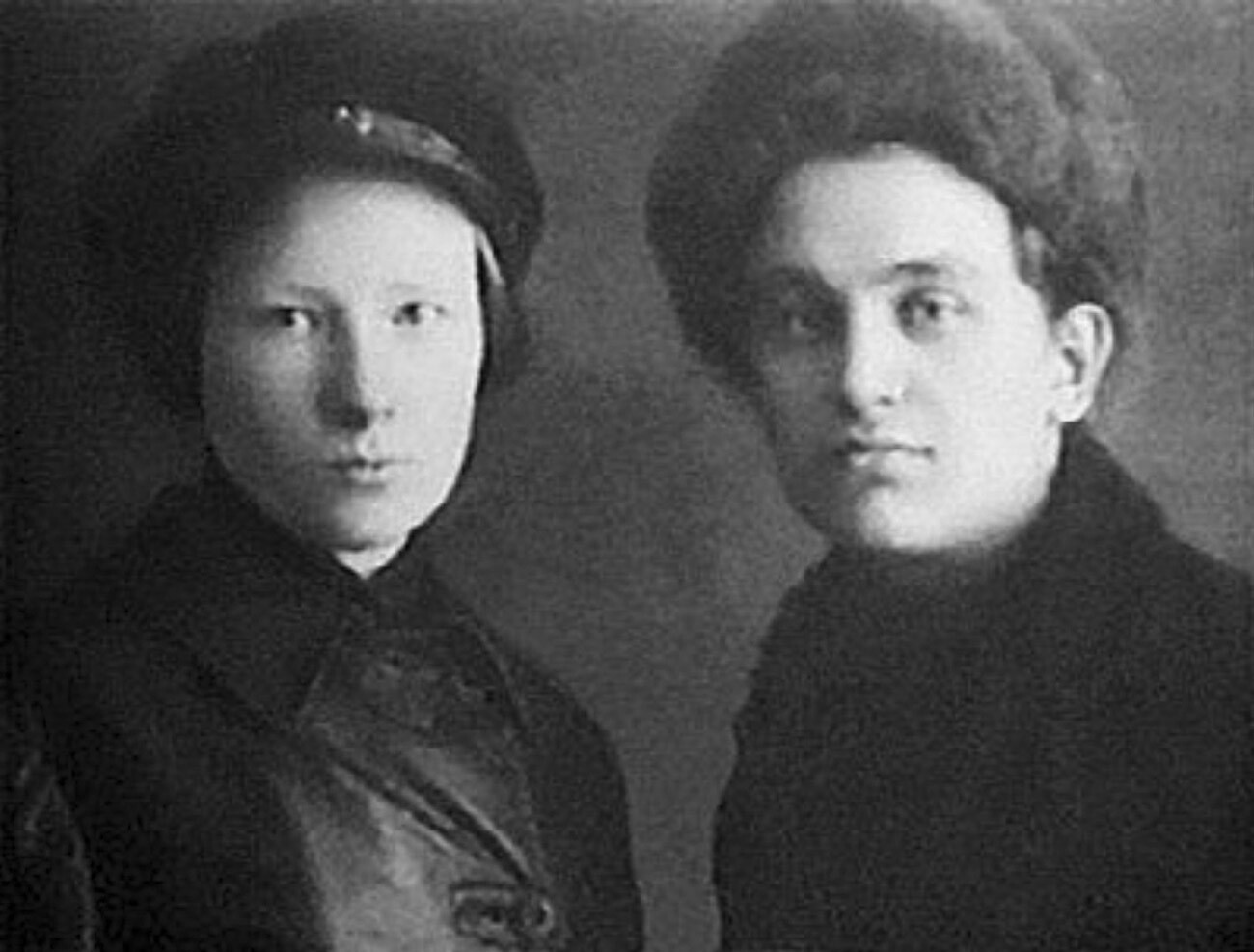
Leonid Nikolayev and Milda Draule.
“Sergei Mironovich Kirov was a great friend of the family from way back…” recalled Svetlana Alliluyeva, the daughter of the ‘Father of the Peoples’. “Kirov accompanied my father on vacation in the summer to Sochi and they used to take me with them. I still have a pile of photographs taken at that time, simple family photos with nothing posed about them… Kirov was closer to my father than [Alexander] Svanidze, all his relatives, [Stanislav] Redens or many of his other work colleagues. Kirov was close to my father and my father needed him.”
Stalin took personal charge of the Kirov case, closely followed the investigation and personally questioned witnesses. It was he who came up with the theory that a group of opposition members led by his opponent in the internal party struggle, Grigory Zinoviev, was behind the Kirov assassination. At the prompting of the supreme leader, this theory was immediately seized upon by the NKVD.
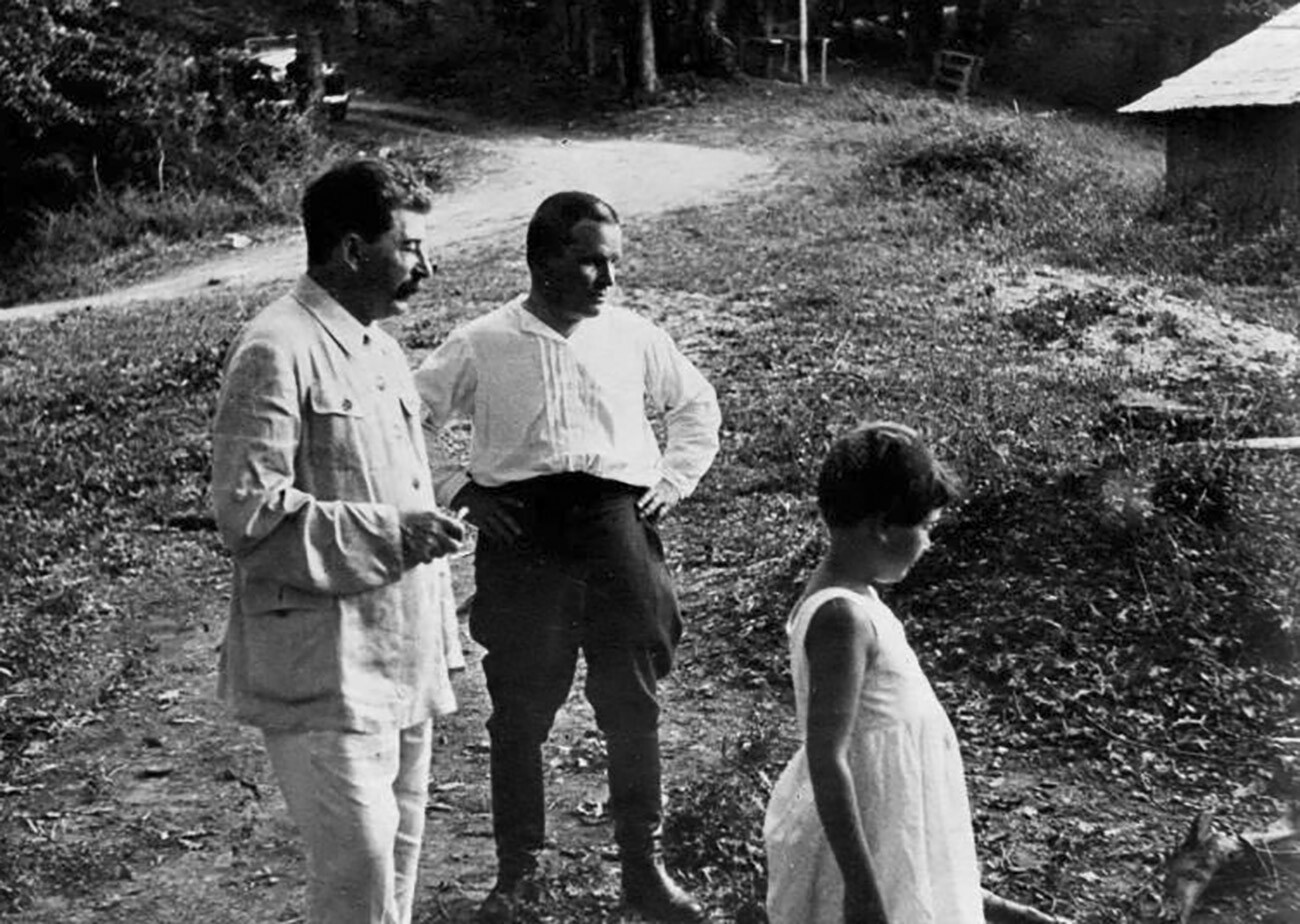
Stalin, his daughter Svetlana and Kirov.
The following words were published in a leading article in the ‘Pravda’ newspaper on December 5: “The vile and underhand agents of the class enemy, the abject scum of the former Zinovievite anti-party group, have snatched Comrade Kirov from our ranks.”
Nikolayev was executed by firing squad on December 29 and Milda Draule, having been pronounced his accomplice, fell to the same fate soon afterwards. Over ten people were also sentenced to death, including Zinoviev and his ideological associate and colleague Lev Kamenev. Subsequently more than 800 of their supporters were subjected to repressions. None of them had been involved in the murder of Kirov.
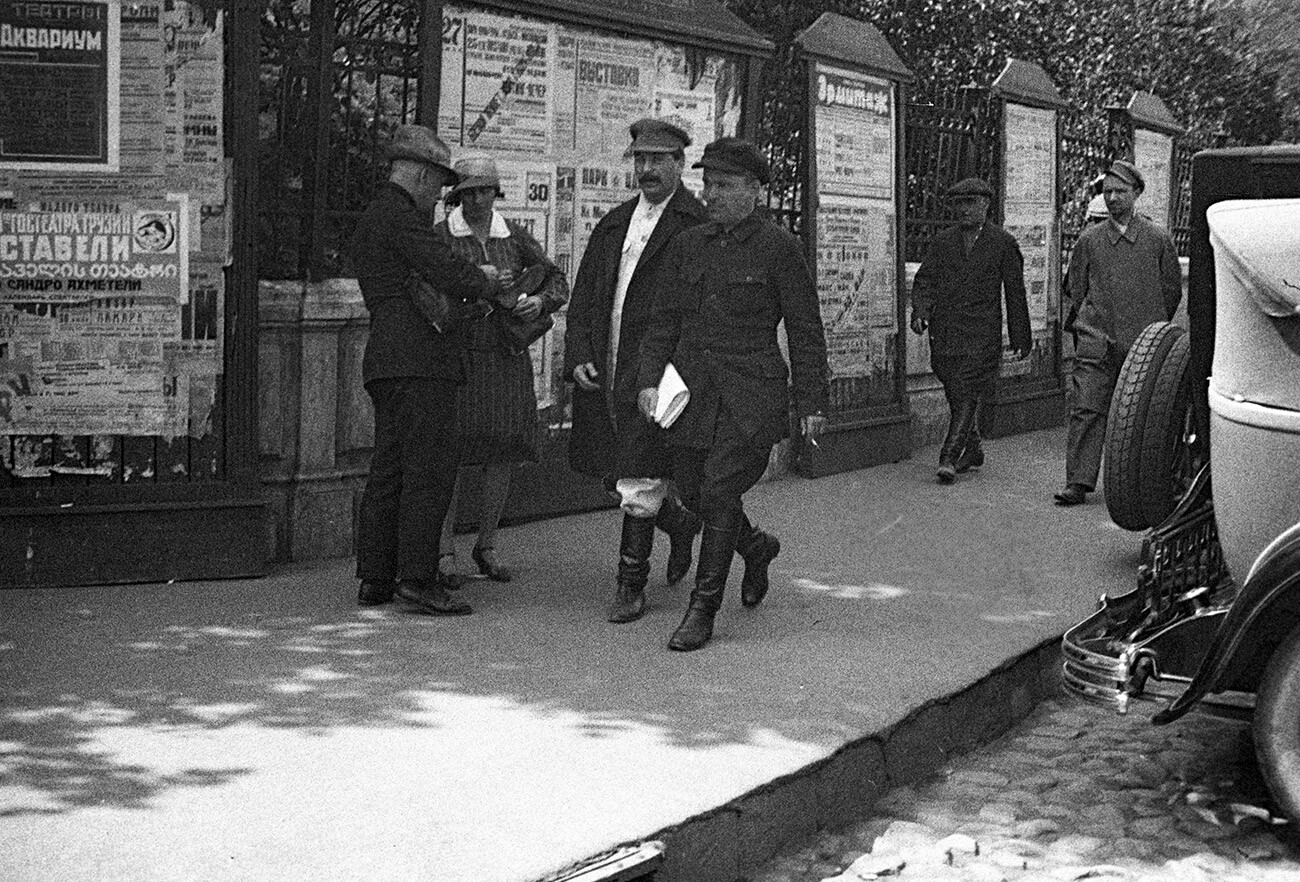
Stalin and Kirov.
Several hundred members of the local NKVD Directorate and the Leningrad Regional Party Committee and City Party Committee were transferred to other duties, dismissed or arrested “for their negligent attitude to their duties”. One way or another, they included all the witnesses to the tragic incident at the Smolny Institute. What is more, Kirov’s bodyguard, who had accompanied his boss to work on that fateful day, was killed in a road accident in mysterious circumstances at the very beginning of the investigation.
Flywheel of repressions
Soviet leader Nikita Khrushchev, who, in 1934, had been first secretary of the Moscow City Committee of the VKP(b), was convinced that Stalin himself stood behind the organization of the murder: “Kirov was the sacrificial victim whose death was used to stir up the country and to get rid of people that didn’t suit Stalin, to dispose of the old Bolsheviks, by accusing them of having engineered the assassination of Kirov.”
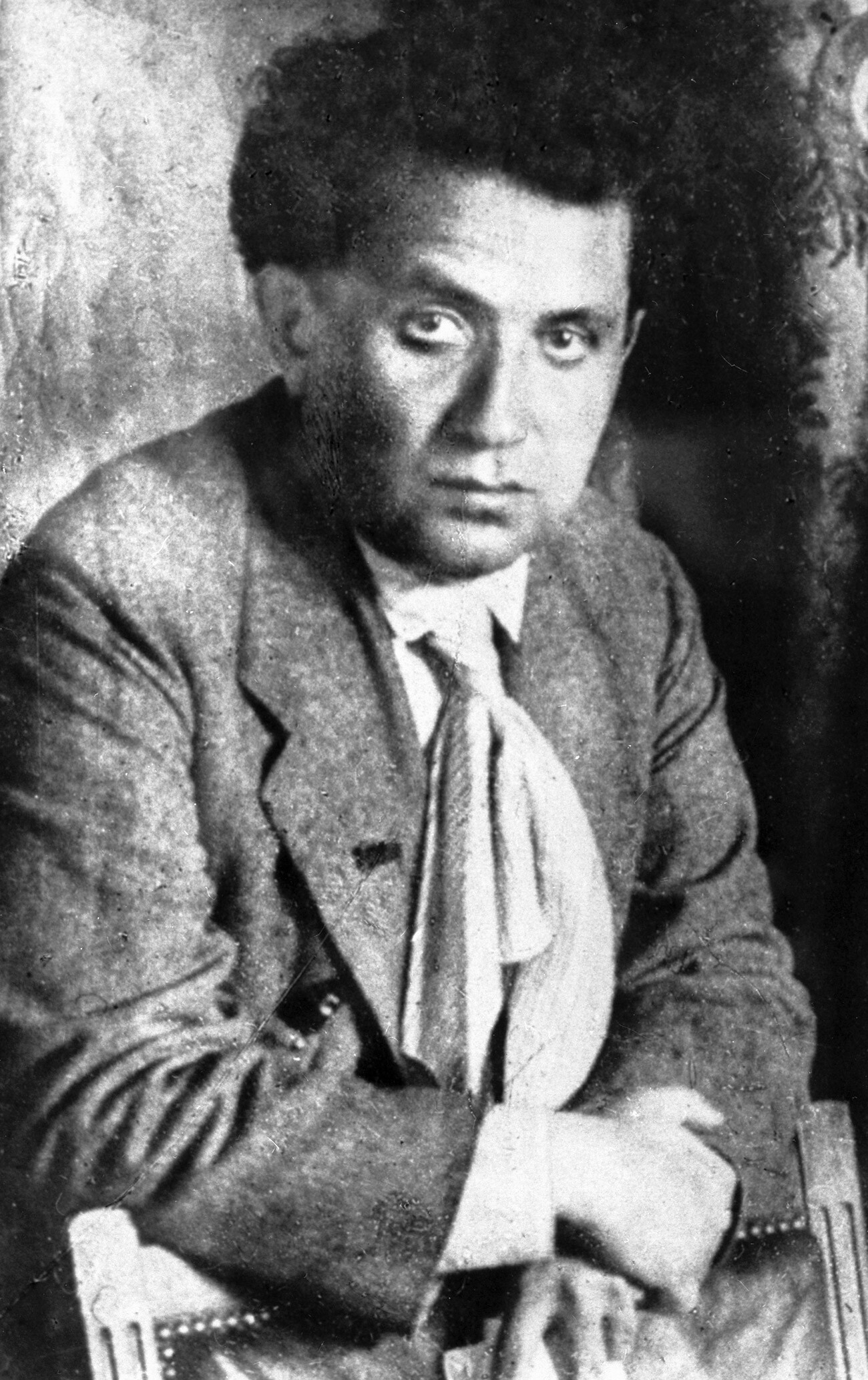
Grigory Zinoviev.
“Of course, it was not Stalin himself who issued the order to Nikolayev,” Khrushchev wrote . “Nikolayev was too insignificant for that. But, I have no doubt that someone had primed him on Stalin’s orders… Nikolayev probably hoped for some sort of leniency. But, it was excessively naive of him to genuinely count on it. This Nikolayev was not so important an individual: He carried out his assignment and thought that his life would be spared. He was just a simpleton. After performing such an order the perpetrator inevitably had to be eliminated to hush up the truth. And, so, Nikolayev was eliminated.”
This theory has also had its opponents. “There are no documents or evidence confirming Stalin’s or the NKVD bodies’ involvement in the murder of Kirov,” wrote Pavel Sudoplatov, one of the heads of the Soviet intelligence services. “I am convinced that the killing of Kirov was an act of personal revenge.”
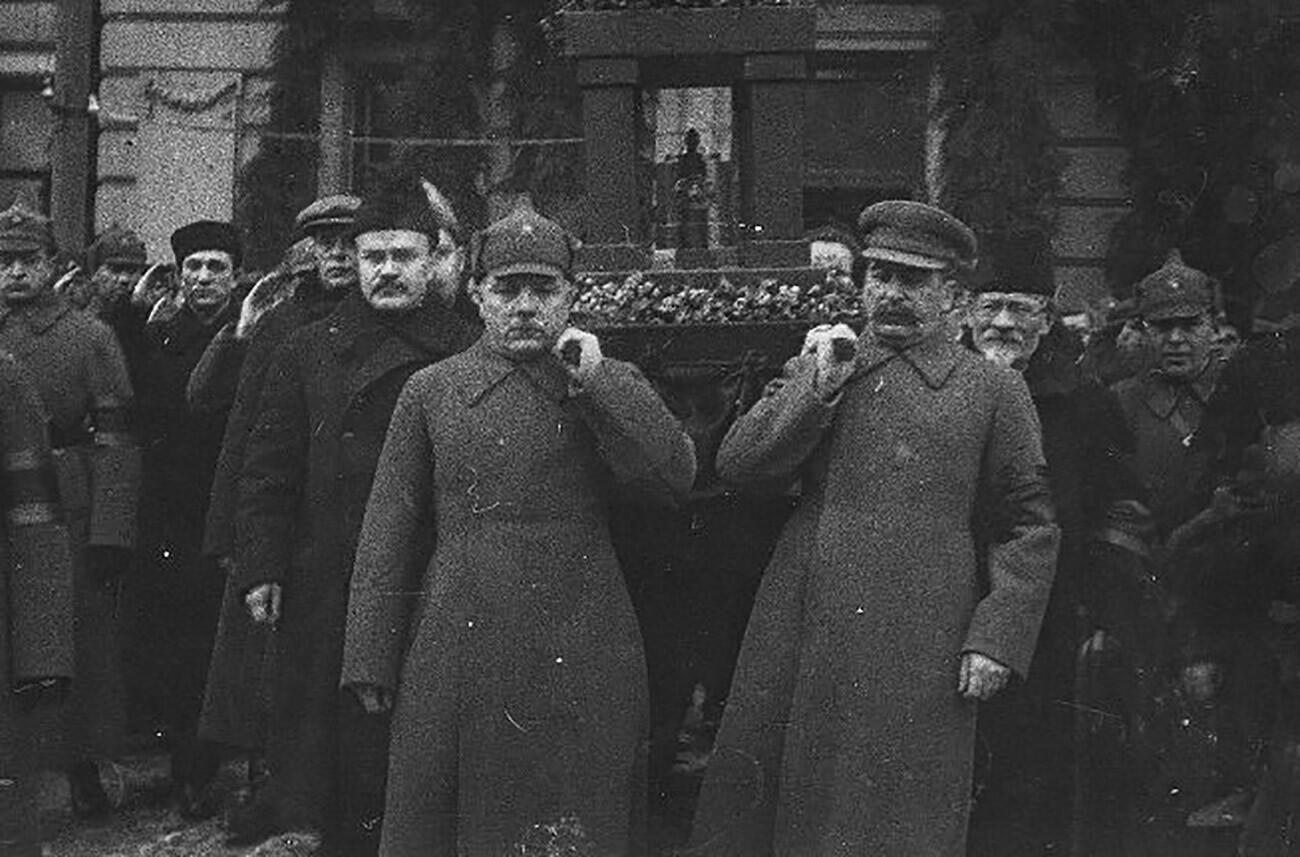
Kirov's funeral procession.
The extent of the ‘Father of the People’s involvement in the death of Kirov remains an open question today. Whatever the case, the Soviet leader skilfully used the incident to crush his political enemies and consolidate his own power.
In the wake of the high-profile crime, the NKVD bodies were given the right to fast-track the cases of those accused of preparing or carrying out “terrorist acts”, without lawyers or the possibility of appeals for clemency. Death sentences started to be carried out immediately after verdicts were pronounced. The flywheel of repressions started to pick up speed and it was only after Stalin’s own death that it was possible to halt it.
If using any of Russia Beyond's content, partly or in full, always provide an active hyperlink to the original material.
to our newsletter!
Get the week's best stories straight to your inbox
- 7 popular legends about Stalin
- How Stalin 'entered' EVERY Soviet home (PHOTOS)
- How Stalin banned Christmas and New Year’s
This website uses cookies. Click here to find out more.
- Share full article
Advertisement
Supported by
Yeltsin Son-in-Law at Center Of Rich Network of Influence
By Michael Wines
- Oct. 7, 1999
It is three hours by air from Moscow to Omsk, a sprawling collection of fraying low-rises set on a Kansas-flat plain by the oil fields of Siberia. Every month or two, a well-dressed, bespectacled young man arrives by commercial jet here and is whisked away to a corporate apartment not far from the Omsk Oil Refinery, Russia's largest and most modern petroleum complex. After a day or two of unspecified business, he leaves as he came.
Virtually nobody in this city of 1.2 million people would notice, except for his name: Leonid Dyachenko, the husband of President Boris N. Yelt sin's daughter and right-hand strategist, Tatyana Dyachenko.
Once so anonymous that even prying reporters were unsure of his first name, the 36-year-old Mr. Dyachenko turns out to have a colorful life.
He popped into the headlines two weeks ago when it was disclosed that he had a bank account in the Cayman Islands with more than $2 million. His bank is the Bank of New York, which is at the center of an investigation into possible money laundering in the United States.
Mr. Dyachenko is an oil trader. But he is more than that. He is a participant -- if not a key figure -- in a network of politically blessed companies that ship Siberian oil products to Ukraine and to Eastern Europe.
His work is all the more colorful because, for many oil traders, oil is almost an afterthought. Virtually all of Russia's oil giants use creative financial transactions to ship billions of dollars offshore -- beyond the reach of tax collectors and, for that matter, company shareholders.
Of most interest to investigators tracing the billions of dollars that have flowed out of Russia this decade are Mr. Dyachenko's bank accounts, which apparently got most of their money from his dealings with oil companies, according to statements by bank officials.
The officials of those companies, and Mr. Dyachenko's benefactors, include two Russian tycoons who are among Mr. Yeltsin's strongest supporters, Boris A. Berezovsky and Roman Abramovich, as well as the son of the autocratic pro-Yeltsin governor of the Omsk region.
Mr. Dyachenko's operations stretch from Omsk to Moscow to Manhattan, where he is allied with a frenetic Russian capitalist named Viktor Y. Khrolenko and, records indicate, seems to have occupied a luxury apartment overlooking New York's financial district.
Mr. Khrolenko, who set up two oil trading companies that employed Mr. Dyachenko and who befriended the Yeltsin family, said in an interview that the Federal Bureau of Investigation had seized his records and that he was recently summoned to appear next Thursday before a Federal grand jury looking into Russian financial dealings in the United States. Through a lawyer, he denied any wrongdoing. The Kremlin has refused in the past to discuss Mr. Dyachenko.
And nothing so far links Mr. Dyachenko to any of the now-infamous companies, like Benex International, that have been indicted on charges of illegally moving nearly $7 billion from Russia through Bank of New York accounts over the last three and a half years.
Still, Mr. Dyachenko's business in Omsk and Manhattan raises questions throughout Moscow about his lucrative relationships with business tycoons who have profited from the personal intervention of Mr. Dyachenko's father-in-law, President Yeltsin.
Less clear is the true role of Mr. Khrolenko, an engaging but curious wheeler-dealer who seems to have played midwife on both sides of the ocean to Mr. Dyachenko's oil career.
Tall, good-looking and energetic, Mr. Khrolenko was a Russian capitalist before Russian capitalism was cool, much less before it overheated. ''Viktor was one of those guys who asked me to smuggle him a copy of Samuelson's book on economics in '78 or '79,'' said Jonathan Sanders, a Columbia University professor who is a godfather to one of Mr. Khrolenko's grandchildren. ''He's a real Russian patriot who just wanted to bring some American things into his country.''
By the time Communism collapsed, Mr. Khrolenko had hooked up with a onetime promoter for the Rolling Stones to secure a CBS recording contract for a Russian rock band and bring Soviet newscasts to the Discovery Channel. He started, then sold, an American-style nightclub, Manhattan Express, in a staid hotel near Red Square, and published books on Russian art and literature.
His corporate umbrella, Belka International, had annual sales of more than than $100 million in 1992, according to a Moscow business newspaper. A more recent report, by Dun & Bradstreet, places recent sales at close to $30 million.
Mr. Sanders believes that Mr. Khrolenko had met Mr. Yeltsin by the late 1980's, when Mr. Yeltsin was gaining the image of a Communist reformer. And Mr. Khrolenko suggested that he met Mr. Yeltsin's son-in-law through a timber deal in the early 1990's.
What is clear is that in 1993, the Kremlin called Andrew Nurnberg, Mr. Yeltsin's literary agent in London, and said Mr. Khrolenko would negotiate the American rights to Mr. Yeltsin's autobiography.
''I heard he was desperate to be seen with Yeltsin,'' Mr. Nurnberg said in a telephone interview. ''That was in those days when you could benefit by being close to the President of Russia.''
Peter Osnos, then the publisher of Times Books, a division of Random House, and now the publisher at Public Affairs, a nonfiction publishing house, said Mr. Yeltsin's book was excellent -- and that the American edition never made a penny.
In an interview, he recalled attending a spectacular Kremlin dinner to celebrate the unveiling of the book at which Mr. Khrolenko sat with the presidential family. ''What happened to him after that, I don't know,'' he said.
Part of what happened is that Mr. Khrolenko went from publishing to petroleum -- and Russian politics. By the spring of 1994, when Mr. Yelt sin's book appeared in the United States, Mr. Khrolenko's Belka was peddling its services at a Washington conference on Russian technology, opened by Vice President Al Gore.
Among others there was the governor of Omsk region, Leonid Polezhayev. A participant, who refused to be identified for fear of retribution, said Mr. Khrolenko was actively promoting oil and gas deals in the area, and that Governor Polezhayev was at his side. ''They hugged each other like old friends,'' the person said. ''I think they'd known each other for a long time.''
A huge deal was soon sealed, but it did not directly involve Mr. Khrolenko.
Under a Government program known as loans for shares, the Kremlin elected to sell off effective control of the Omsk Oil Refinery, the city's biggest employer, to the highest bidder. That triggered a bitter battle that ended when the chief opponent of the plan, the refinery's general director, was found dead in Omsk's Irtysh River a week before the company's auction.
The winner of the auction was the huge Siberian Oil Company, known as Sibneft. Its ownership is murky at best, but most analysts say control rests with the company's general director, Mr. Abramovich (pronounced ah-bra-MO-vich), and his longtime business ally, Mr. Berezovsky, perhaps Russia's richest and most public business titan.
The Sibneft acquisition appears to have been good news for both Mr. Khrolenko and Mr. Dyachenko. Sibneft began selling its refined Siberian oil through a network of oil traders. At the top of Sibneft's list were two companies: a Khrolenko creation called Belka Energy of New York, and a second, better-known Russian company called Runikom.
By all accounts, Mr. Dyachenko has either overseen or played a leading role in Belka's dealings with the Omsk refinery. A vice president of Runikom, which itself holds a 10 percent share of Sibneft, is none other than Aleksei Polezhayev, the son of the Omsk governor.
The incestuous nature of the ties is clear from the location of Belka's Moscow office: in the refurbished building that houses representatives of the Omsk regional government.
As a practical matter, Sibneft seems to have awarded the relatives of Mr. Yeltsin and a key supporter lucrative contracts to distribute its petroleum products. Just how lucrative is not clear; Sibneft, one of the world's biggest oil companies, still does not have to disclose its internal business dealings.
Mr. Khrolenko's lawyer, Irwin Rochman, said in a lengthy interview that Mr. Khrolenko's companies are legitimate and that Mr. Dyachenko, who has an undisclosed ''relationship'' with them, ''has been compensated handsomely'' for his work.
But it is unclear what Mr. Dyachenko does.
According to an account by one petroleum expert in Omsk, which is impossible to verify, Belka and a second Khrolenko company run by Mr. Dyachenko, East Coast Petroleum, move about 10,000 tons of diesel fuel from Omsk each month. Most goes to former Soviet satellites like Hungary and Croatia; increasingly, some goes to Ukraine.
''It's crumbs, mere crumbs,'' the expert said. Like many experts, he characterized the allotment as a political favor, much as a powerful American company might suddenly choose to hire the unexceptional son of a congressman or a governor.
But the sums involved -- and the profits -- can be immense. The vast majority of Russian oil giants effectively launder their oil through a network of offshore companies -- some wholly owned subsidiaries, others controlled by favored friends -- to avoid taxes.
The Russian Government places a 20 percent value-added tax on every ton of exported oil or gas. In the simplest scheme, an oil company agrees to sell its crude to a foreign trader for slightly below the market price, thereby understating its profit and paying less tax. The trader then resells the oil at market prices and agrees to split the profit with his supplier.
Most important, the unreported profit stays offshore. ''If you have an offshore entity, you can declare less income and pay less taxes -- excise, profit, corporate or income tax,'' said an executive of one major Western company.
The rake-off goes largely to feed official corruption, lining the pockets of politicians and company officials. In particular, both Russian and foreign oil executives say, the Government's energy and fuel ministry -- which controls oil exports -- is almost brazenly corrupt.
Even officially, the Government does little to conceal the practice. In 1997, a banner year for oil exports, nearly half of the 97 million tons of crude oil exports were sent -- on paper, at least -- to tax havens like Gibraltar, Lichtenstein and the Bahamas, many without refineries.
A review of Russian customs records by a Russian petroleum newsletter turned up no evidence that either Belka or East Coast Petroleum had received oil exports in the last two years. That could be literally true. But experts say it is possible that the two companies could be placed further offshore in a chain of transactions beyond the reach of Russian tax collectors.
In Omsk, where at least some of the records exist, even those in the know do not want to talk about it.
Journalists who have challenged Governor Polezhayev's rule have found themselves under investigation.
In one interview this week, a subject removed the batteries from a mobile telephone, explaining calmly that this would prevent the security police from monitoring the interview. The governor's office declined a reporter's request to discuss these and other issues.
''The less you know,'' said one man who declined to delve deeply into Belka's history, ''the longer you live.''

IMAGES
VIDEO
COMMENTS
Leonid Teliga (28 May 1917 - 21 May 1970) was a Polish sailor, writer, journalist, translator, and the first Pole to single-handedly circumnavigate the globe on his yawl Opty. ... Sailing yacht Opty - boat of Leonid Teliga, the first Pole who single-handedly circumnavigated the globe.
Leonid Teliga jest patronem Yacht Clubu OPTY z siedzibą w Chełmie Śląskim przy ulicy jego imienia. Od 9 czerwca 1973 imię Leonida Teligi nosi Szkoła Podstawowa nr 3 w Myśliborzu [6] . Od 28 maja 1976 imię Leonida Teligi nosi Szkoła Podstawowa nr 5 w Grodzisku Mazowieckim [7] .
OPTY - yacht which sailed around the world. Publication date: 14 April 2015. A solitary cruise, a murderous struggle against time and illness, an obsession to sail round the world without any help or support, with only a yacht and oneself to rely on. Leonid Teliga is still recognized as a symbol of a romantic struggle and an extraordinary sea ...
Leonid Teliga was born on 21st May 1917 in Vyazma, Russia, but spent his childhood and youth in Grodzisk Mazowiecki. Inspired by books by Wagner and Zaruski, he dreamt of sea voyages. ... While raising funds for the construction of his yacht, Leonid Teliga used to say: "If I manage to build this yacht, I will call her OPTY-mista [OPTI-mist], if ...
That man was Leonid Teliga. In the 1960s, a remarkable record-breaking journey took place that thrilled people in Poland, who back then were largely isolated behind the Iron Curtain. Stopping in places like Barbados and Tahiti, the trip wasn't about breaking a speed record but about one man's love for sailing. That man was Leonid Teliga.
Leonid Teliga is a yacht construction type Conrad 54, built in Poland in the second half of the 1970s. Five such yachts were built. Currently sailing yachts Conrad 54 are Lady B., Tornado, Lietuva and our Leonid Teliga. Leonid had a major renovation in 2017 and since then has been sailing on European waters from the Baltic to the Canary Islands.
In 2019, we have been celebrating the 50th anniversary of the end of voyage by Leonid Teliga on board of "Opty". "I am sailing "Opty" Exhibition. Treasures from the voyage around the globe in the Vistula Museum in Tczew present the history of great adventure, legendary sailor and yacht - the symbol.
She was a ship construction engineer and as such had in-depth knowledge of how to service a yacht - an ability that is priceless at sea. As to her own motivation, she wanted to prove that a woman was capable of sailing across the world alone (the feat had been accomplished by men before, by, among others, Poland's own Leonid Teliga ...
Powrót. Legendarne okręty i jachty. Opty. Data wodowania - 1966. Port - Gdynia. Firma - Leonid Teliga. Typ platformy - yawl. After the-round-the-world cruise, the yacht was used by the Gdynia Maritime Academy and was then given to the Central Maritime Museum in Gdańsk. Now, it is kept in the Vistula River Museum in Tczew, where it is waiting ...
Leonid Teliga (28 May 1917 - 21 May 1970) was a Polish sailor, writer, journalist, translator and the first Pole to single-handedly circumnavigate the globe on his yawl Opty. ... The yacht Opty was designed by engineer Leon Tumiłowicz, based on his earlier construction, the Tuńczyk class, but modified so that it would better fit the task of ...
background: another stage in the solitary journey of lone yachtsman leonid teliga was reached on monday when he sailed his yacht 'opty' into dakar harbour after a five-month crossing of the pacific ocean. teliga, a 51-year old polish national, started his marathon voyage in april 1967 when he set sail from las palmas to cross the atlantic.
Built as a yacht in Gdynia by Leonid Teliga (1917-1970) in his backyard, Poland, ... Teliga received some support from the Polish Yachting Association and other sources, but most of the funding he was paying himself. The yacht was transported to Casablanca as deck cargo on board the freighter SLUPSK, and on 25 January 1967 he set sail from this ...
Poznaj historię życia i ciężkiej pracy szkutników. 30.06.2023 - 16.06.2024 Muzeum Wisły w Tczewie
A beautiful Leonid Teligi Marine Shipyard Trygław (2014) sailing yacht for sale from Poland, Lublin. Listing id #6344 - Updated Price. For more models contact itBoat. Explore. ... The yacht was built at the Teligi Shipyard in Szczecin in 1976 and in 2014 she underwent a major refit. At present she is fully refurbished and modernized, including ...
25 stycznia 1967 r. polski żeglarz Leonid Teliga, wyruszył z Casablanki w Maroku w samotny rejs dookoła świata na swoim jachcie OPTY. Rejs ten trwał dwa lata...
Leonid Teliga was a Polish sailor, writer, journalist, translator and the first Pole to single-handedly circumnavigate the globe on his yawl Opty. ... and other sources, Teliga funded the construction mostly on his own. Even though masts and booms were wooden, the yacht was farily well equipped, as it had a pneumatic raft, a plastic boat for ...
Builder : Maritime Yacht Shipyard 'Leonid Teliga' Year of build : 1989 Flag : Estonia Port of registry: Roomassaare Status of ship : In Service/Commission Registered owner : - Media in category "Regina (ship, 1989)" This category contains only the following file.
Biography. S/y Zryw was built in 1978 in the Maritime Yacht Shipyard of Leonid Teliga. She is used as a sail training vessel for adolescents and to help them pass the Polish Certificate of Competency. These young sailors gather experience from voyages in the Baltic Sea. Within the last 2 years, Zryw sailed twice around the Baltic and once to ...
Leonid Teliga (28 May 1917 - 21 May 1970) was a Polish sailor, writer, journalist, translator, and the first Pole to single-handedly circumnavigate the globe on his yawl Opty.. Life Youth. Although he was born in Russia, his parents decided to settle back in Poland after it regained independence. He was raised in Grodzisk Mazowiecki.After failing to get into medical studies, he decided to ...
Joseph Stalin and Sergei Kirov. Public Domain. Follow Russia Beyond on Telegram. Joseph Stalin took personal charge of the investigation into the murder of his comrade and friend Sergei Kirov. And ...
Leonid Dyachenko, husband of Russian Pres Boris N Yeltsin's daughter Tatyana Dyachenko, has bank account in Cayman Islands with over $2 million; his bank is Bank of New York, which is at center of ...
Best Places to Stay in Moscow. 9 Things to Do on a Moscow City Break. Visit the Iconic Sites on Red Square (a UNESCO World Heritage Site) The Kremlin. St Basil's Cathedral. Lenin's Mausoleum. GUM Department Store. Visit Moscow Metro Stations. Novodevichy Convent.